City Logistics Management: Strategies for Two Cities
VerifiedAdded on 2022/08/20
|10
|1507
|15
Report
AI Summary
This report delves into city logistics management, focusing on the urban environments of Tumon, Guam, and Accra, Ghana. It examines the factors influencing the selection of logistics strategies, including business activity, infrastructure, logistics service providers, population distribution, and consumption habits. The report proposes the implementation of satellite and cross-dock facilities for Tumon, justifying this choice based on the area's tourism-driven economy and congested roadways. For Accra, Ghana, the report advocates for a direct-to-customer delivery strategy, considering the city's population distribution and existing infrastructure. The report concludes by highlighting the potential of these strategies for enhancing logistics efficiency and addressing distribution challenges in both cities, supported by a comprehensive bibliography of relevant sources.
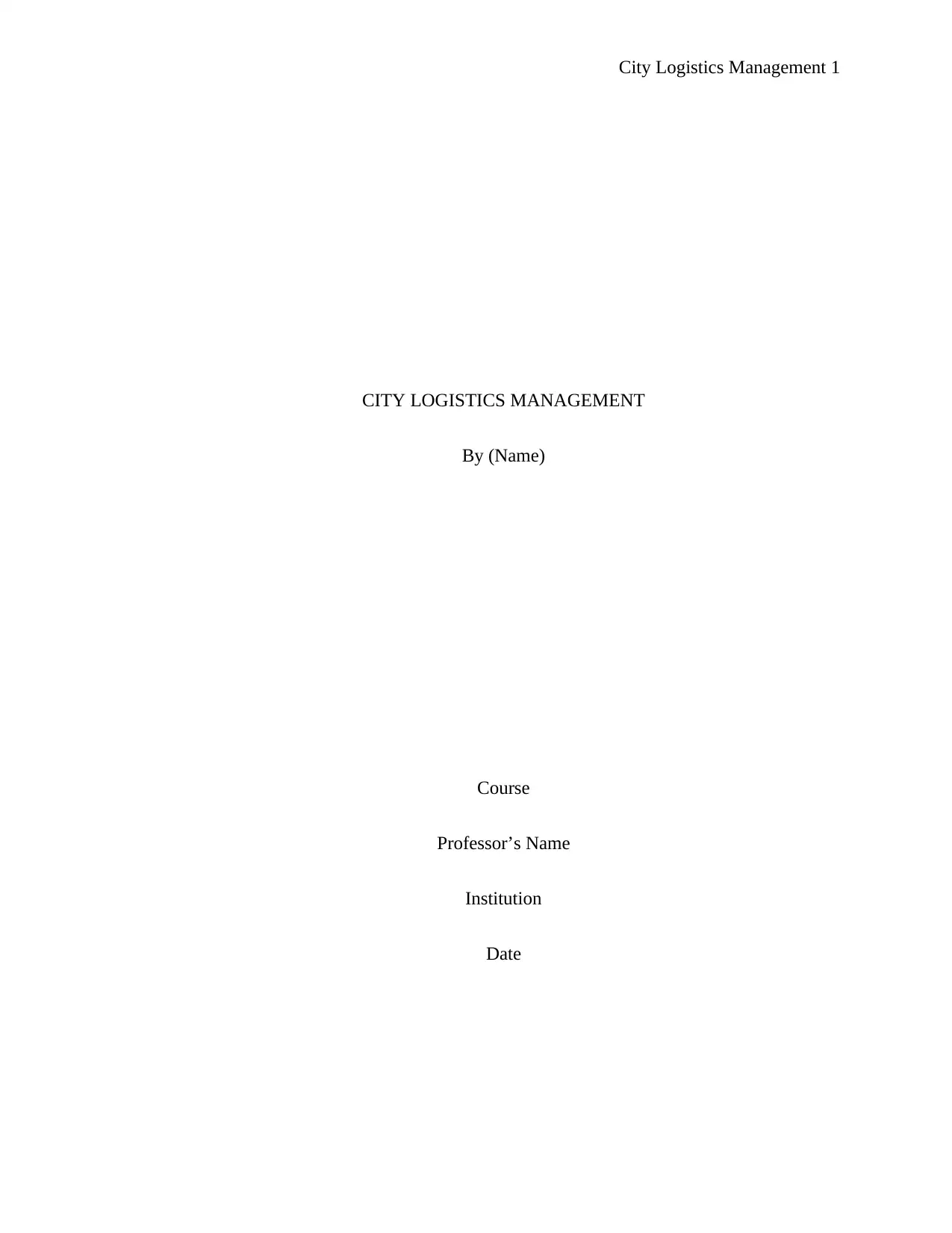
City Logistics Management 1
CITY LOGISTICS MANAGEMENT
By (Name)
Course
Professor’s Name
Institution
Date
CITY LOGISTICS MANAGEMENT
By (Name)
Course
Professor’s Name
Institution
Date
Paraphrase This Document
Need a fresh take? Get an instant paraphrase of this document with our AI Paraphraser
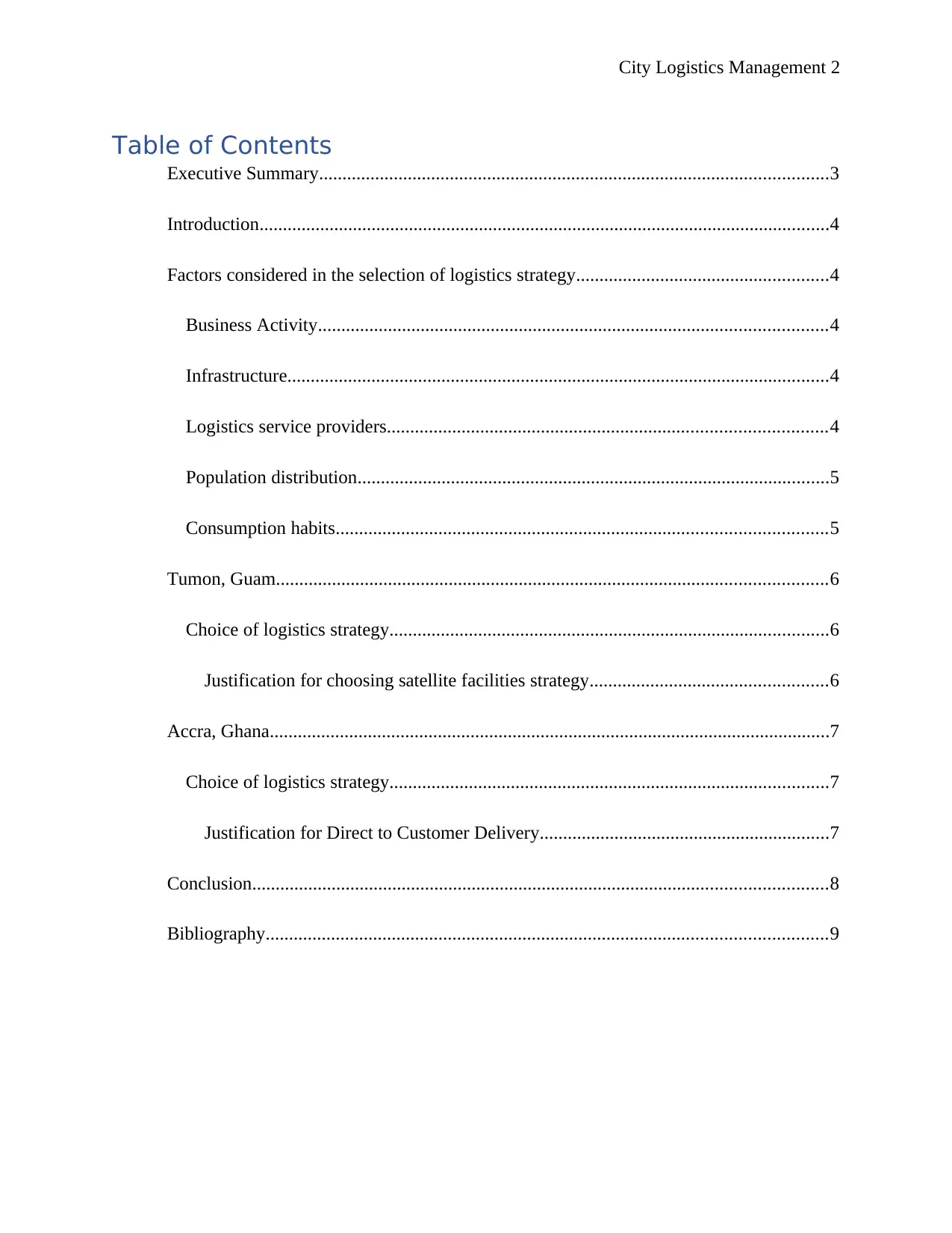
City Logistics Management 2
Table of Contents
Executive Summary.............................................................................................................3
Introduction..........................................................................................................................4
Factors considered in the selection of logistics strategy......................................................4
Business Activity.............................................................................................................4
Infrastructure....................................................................................................................4
Logistics service providers..............................................................................................4
Population distribution.....................................................................................................5
Consumption habits.........................................................................................................5
Tumon, Guam......................................................................................................................6
Choice of logistics strategy..............................................................................................6
Justification for choosing satellite facilities strategy...................................................6
Accra, Ghana........................................................................................................................7
Choice of logistics strategy..............................................................................................7
Justification for Direct to Customer Delivery..............................................................7
Conclusion...........................................................................................................................8
Bibliography........................................................................................................................9
Table of Contents
Executive Summary.............................................................................................................3
Introduction..........................................................................................................................4
Factors considered in the selection of logistics strategy......................................................4
Business Activity.............................................................................................................4
Infrastructure....................................................................................................................4
Logistics service providers..............................................................................................4
Population distribution.....................................................................................................5
Consumption habits.........................................................................................................5
Tumon, Guam......................................................................................................................6
Choice of logistics strategy..............................................................................................6
Justification for choosing satellite facilities strategy...................................................6
Accra, Ghana........................................................................................................................7
Choice of logistics strategy..............................................................................................7
Justification for Direct to Customer Delivery..............................................................7
Conclusion...........................................................................................................................8
Bibliography........................................................................................................................9
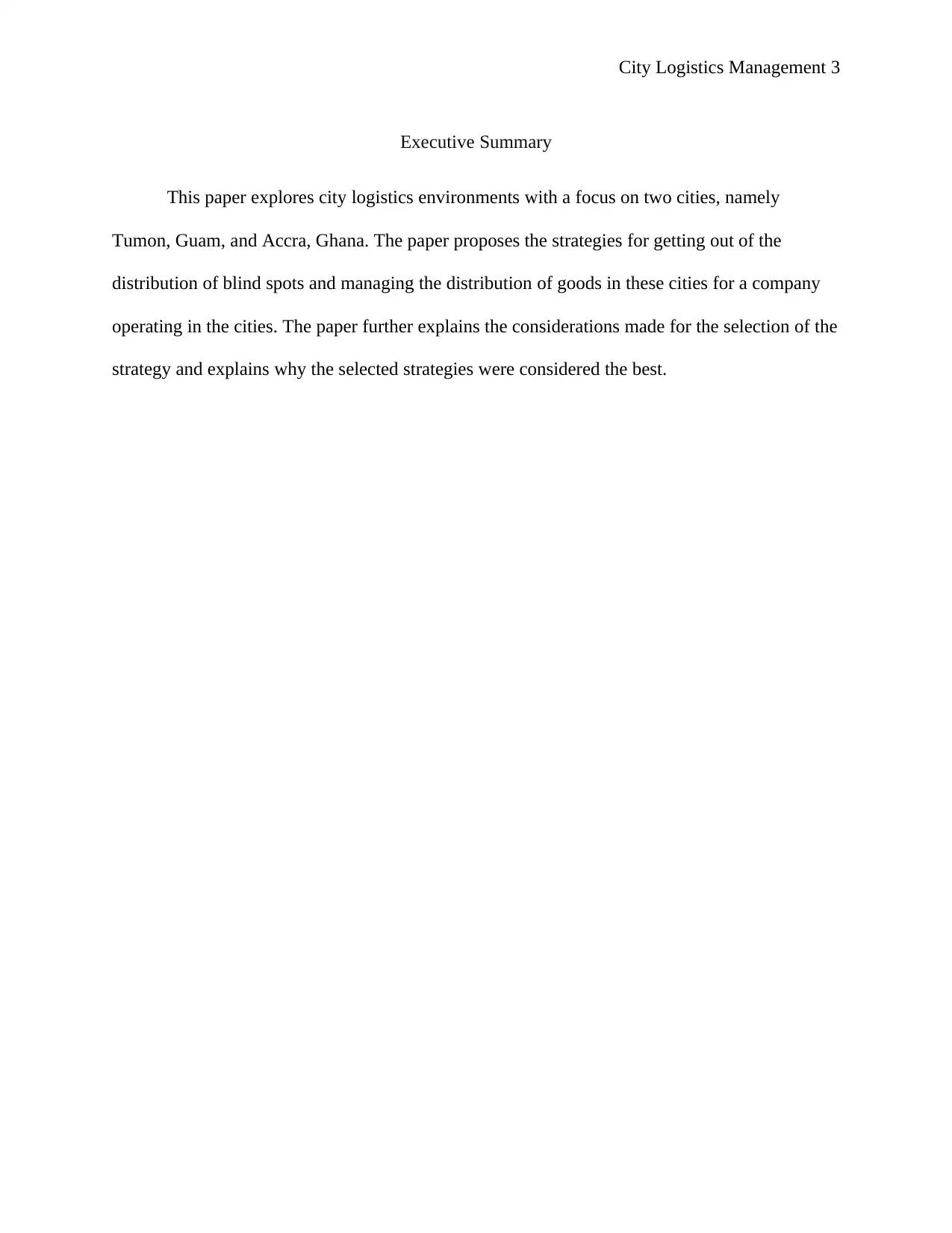
City Logistics Management 3
Executive Summary
This paper explores city logistics environments with a focus on two cities, namely
Tumon, Guam, and Accra, Ghana. The paper proposes the strategies for getting out of the
distribution of blind spots and managing the distribution of goods in these cities for a company
operating in the cities. The paper further explains the considerations made for the selection of the
strategy and explains why the selected strategies were considered the best.
Executive Summary
This paper explores city logistics environments with a focus on two cities, namely
Tumon, Guam, and Accra, Ghana. The paper proposes the strategies for getting out of the
distribution of blind spots and managing the distribution of goods in these cities for a company
operating in the cities. The paper further explains the considerations made for the selection of the
strategy and explains why the selected strategies were considered the best.
⊘ This is a preview!⊘
Do you want full access?
Subscribe today to unlock all pages.

Trusted by 1+ million students worldwide
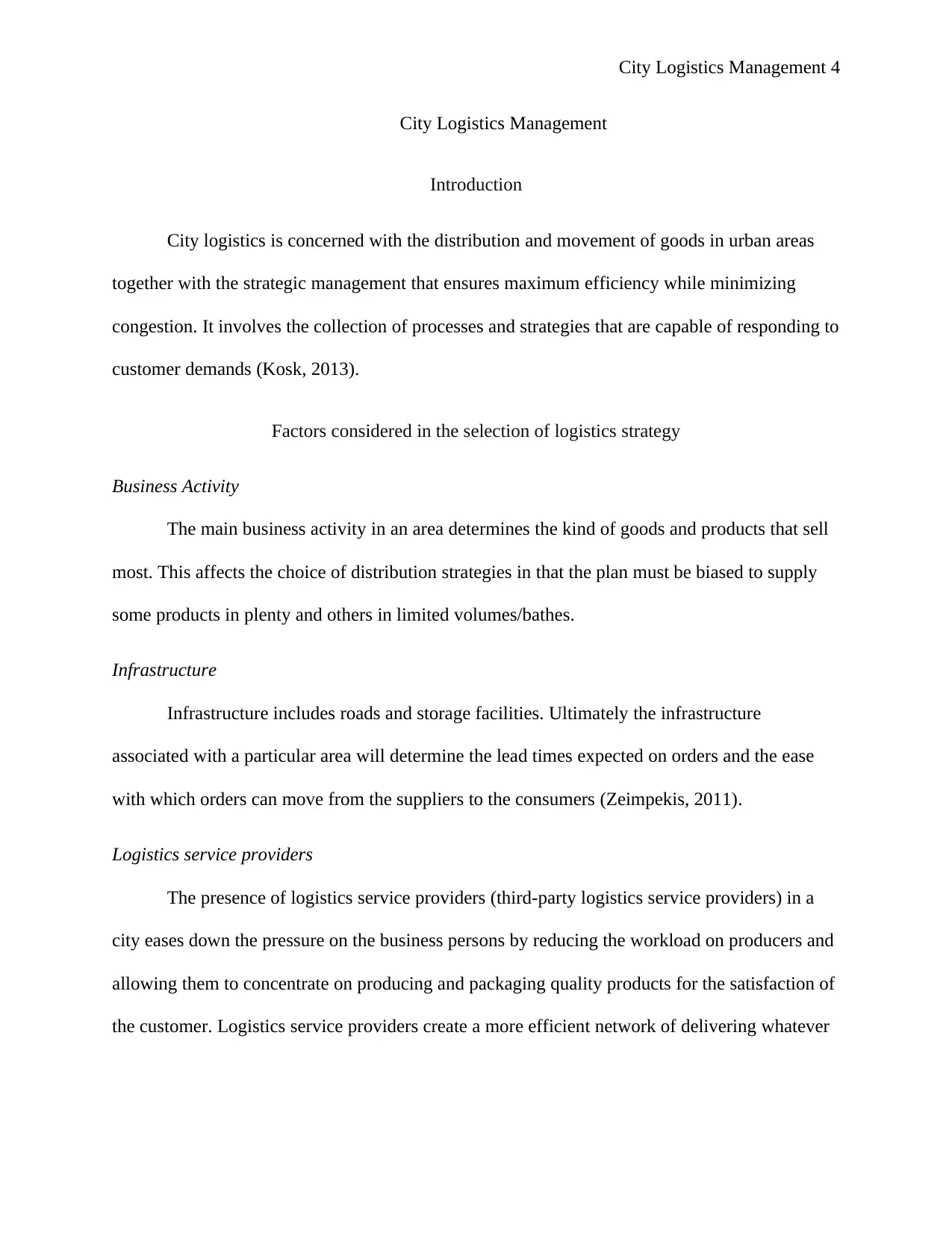
City Logistics Management 4
City Logistics Management
Introduction
City logistics is concerned with the distribution and movement of goods in urban areas
together with the strategic management that ensures maximum efficiency while minimizing
congestion. It involves the collection of processes and strategies that are capable of responding to
customer demands (Kosk, 2013).
Factors considered in the selection of logistics strategy
Business Activity
The main business activity in an area determines the kind of goods and products that sell
most. This affects the choice of distribution strategies in that the plan must be biased to supply
some products in plenty and others in limited volumes/bathes.
Infrastructure
Infrastructure includes roads and storage facilities. Ultimately the infrastructure
associated with a particular area will determine the lead times expected on orders and the ease
with which orders can move from the suppliers to the consumers (Zeimpekis, 2011).
Logistics service providers
The presence of logistics service providers (third-party logistics service providers) in a
city eases down the pressure on the business persons by reducing the workload on producers and
allowing them to concentrate on producing and packaging quality products for the satisfaction of
the customer. Logistics service providers create a more efficient network of delivering whatever
City Logistics Management
Introduction
City logistics is concerned with the distribution and movement of goods in urban areas
together with the strategic management that ensures maximum efficiency while minimizing
congestion. It involves the collection of processes and strategies that are capable of responding to
customer demands (Kosk, 2013).
Factors considered in the selection of logistics strategy
Business Activity
The main business activity in an area determines the kind of goods and products that sell
most. This affects the choice of distribution strategies in that the plan must be biased to supply
some products in plenty and others in limited volumes/bathes.
Infrastructure
Infrastructure includes roads and storage facilities. Ultimately the infrastructure
associated with a particular area will determine the lead times expected on orders and the ease
with which orders can move from the suppliers to the consumers (Zeimpekis, 2011).
Logistics service providers
The presence of logistics service providers (third-party logistics service providers) in a
city eases down the pressure on the business persons by reducing the workload on producers and
allowing them to concentrate on producing and packaging quality products for the satisfaction of
the customer. Logistics service providers create a more efficient network of delivering whatever
Paraphrase This Document
Need a fresh take? Get an instant paraphrase of this document with our AI Paraphraser
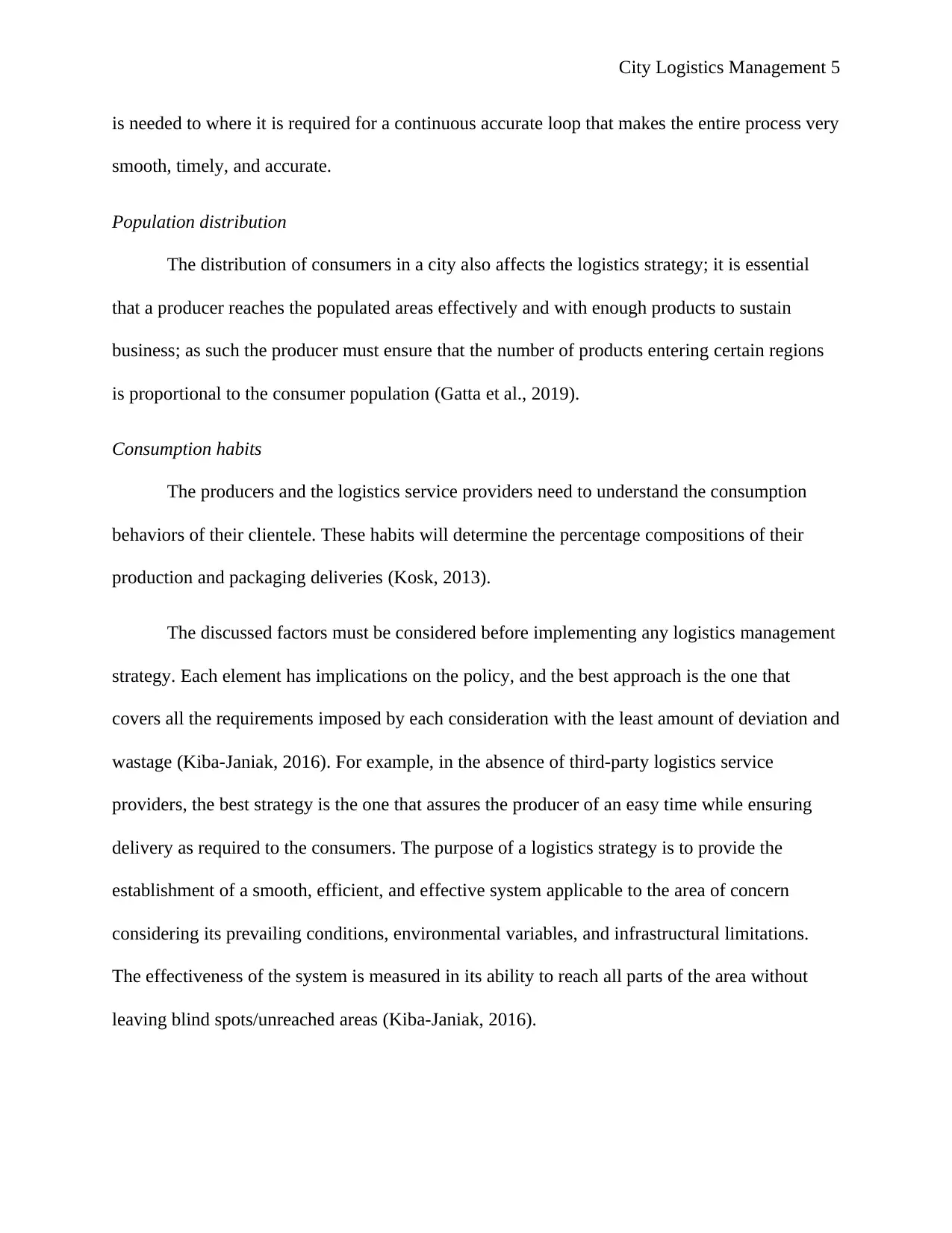
City Logistics Management 5
is needed to where it is required for a continuous accurate loop that makes the entire process very
smooth, timely, and accurate.
Population distribution
The distribution of consumers in a city also affects the logistics strategy; it is essential
that a producer reaches the populated areas effectively and with enough products to sustain
business; as such the producer must ensure that the number of products entering certain regions
is proportional to the consumer population (Gatta et al., 2019).
Consumption habits
The producers and the logistics service providers need to understand the consumption
behaviors of their clientele. These habits will determine the percentage compositions of their
production and packaging deliveries (Kosk, 2013).
The discussed factors must be considered before implementing any logistics management
strategy. Each element has implications on the policy, and the best approach is the one that
covers all the requirements imposed by each consideration with the least amount of deviation and
wastage (Kiba-Janiak, 2016). For example, in the absence of third-party logistics service
providers, the best strategy is the one that assures the producer of an easy time while ensuring
delivery as required to the consumers. The purpose of a logistics strategy is to provide the
establishment of a smooth, efficient, and effective system applicable to the area of concern
considering its prevailing conditions, environmental variables, and infrastructural limitations.
The effectiveness of the system is measured in its ability to reach all parts of the area without
leaving blind spots/unreached areas (Kiba-Janiak, 2016).
is needed to where it is required for a continuous accurate loop that makes the entire process very
smooth, timely, and accurate.
Population distribution
The distribution of consumers in a city also affects the logistics strategy; it is essential
that a producer reaches the populated areas effectively and with enough products to sustain
business; as such the producer must ensure that the number of products entering certain regions
is proportional to the consumer population (Gatta et al., 2019).
Consumption habits
The producers and the logistics service providers need to understand the consumption
behaviors of their clientele. These habits will determine the percentage compositions of their
production and packaging deliveries (Kosk, 2013).
The discussed factors must be considered before implementing any logistics management
strategy. Each element has implications on the policy, and the best approach is the one that
covers all the requirements imposed by each consideration with the least amount of deviation and
wastage (Kiba-Janiak, 2016). For example, in the absence of third-party logistics service
providers, the best strategy is the one that assures the producer of an easy time while ensuring
delivery as required to the consumers. The purpose of a logistics strategy is to provide the
establishment of a smooth, efficient, and effective system applicable to the area of concern
considering its prevailing conditions, environmental variables, and infrastructural limitations.
The effectiveness of the system is measured in its ability to reach all parts of the area without
leaving blind spots/unreached areas (Kiba-Janiak, 2016).
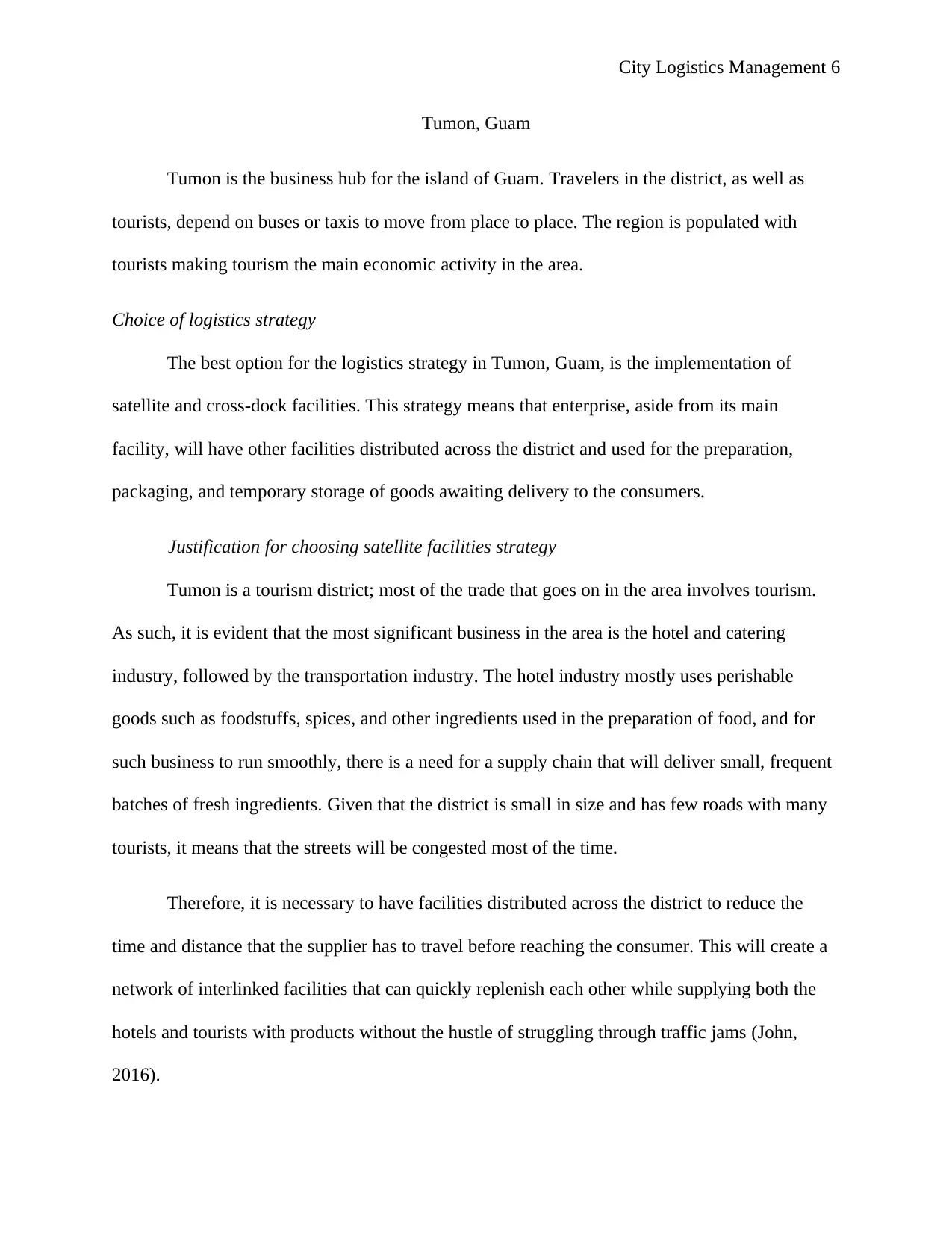
City Logistics Management 6
Tumon, Guam
Tumon is the business hub for the island of Guam. Travelers in the district, as well as
tourists, depend on buses or taxis to move from place to place. The region is populated with
tourists making tourism the main economic activity in the area.
Choice of logistics strategy
The best option for the logistics strategy in Tumon, Guam, is the implementation of
satellite and cross-dock facilities. This strategy means that enterprise, aside from its main
facility, will have other facilities distributed across the district and used for the preparation,
packaging, and temporary storage of goods awaiting delivery to the consumers.
Justification for choosing satellite facilities strategy
Tumon is a tourism district; most of the trade that goes on in the area involves tourism.
As such, it is evident that the most significant business in the area is the hotel and catering
industry, followed by the transportation industry. The hotel industry mostly uses perishable
goods such as foodstuffs, spices, and other ingredients used in the preparation of food, and for
such business to run smoothly, there is a need for a supply chain that will deliver small, frequent
batches of fresh ingredients. Given that the district is small in size and has few roads with many
tourists, it means that the streets will be congested most of the time.
Therefore, it is necessary to have facilities distributed across the district to reduce the
time and distance that the supplier has to travel before reaching the consumer. This will create a
network of interlinked facilities that can quickly replenish each other while supplying both the
hotels and tourists with products without the hustle of struggling through traffic jams (John,
2016).
Tumon, Guam
Tumon is the business hub for the island of Guam. Travelers in the district, as well as
tourists, depend on buses or taxis to move from place to place. The region is populated with
tourists making tourism the main economic activity in the area.
Choice of logistics strategy
The best option for the logistics strategy in Tumon, Guam, is the implementation of
satellite and cross-dock facilities. This strategy means that enterprise, aside from its main
facility, will have other facilities distributed across the district and used for the preparation,
packaging, and temporary storage of goods awaiting delivery to the consumers.
Justification for choosing satellite facilities strategy
Tumon is a tourism district; most of the trade that goes on in the area involves tourism.
As such, it is evident that the most significant business in the area is the hotel and catering
industry, followed by the transportation industry. The hotel industry mostly uses perishable
goods such as foodstuffs, spices, and other ingredients used in the preparation of food, and for
such business to run smoothly, there is a need for a supply chain that will deliver small, frequent
batches of fresh ingredients. Given that the district is small in size and has few roads with many
tourists, it means that the streets will be congested most of the time.
Therefore, it is necessary to have facilities distributed across the district to reduce the
time and distance that the supplier has to travel before reaching the consumer. This will create a
network of interlinked facilities that can quickly replenish each other while supplying both the
hotels and tourists with products without the hustle of struggling through traffic jams (John,
2016).
⊘ This is a preview!⊘
Do you want full access?
Subscribe today to unlock all pages.

Trusted by 1+ million students worldwide
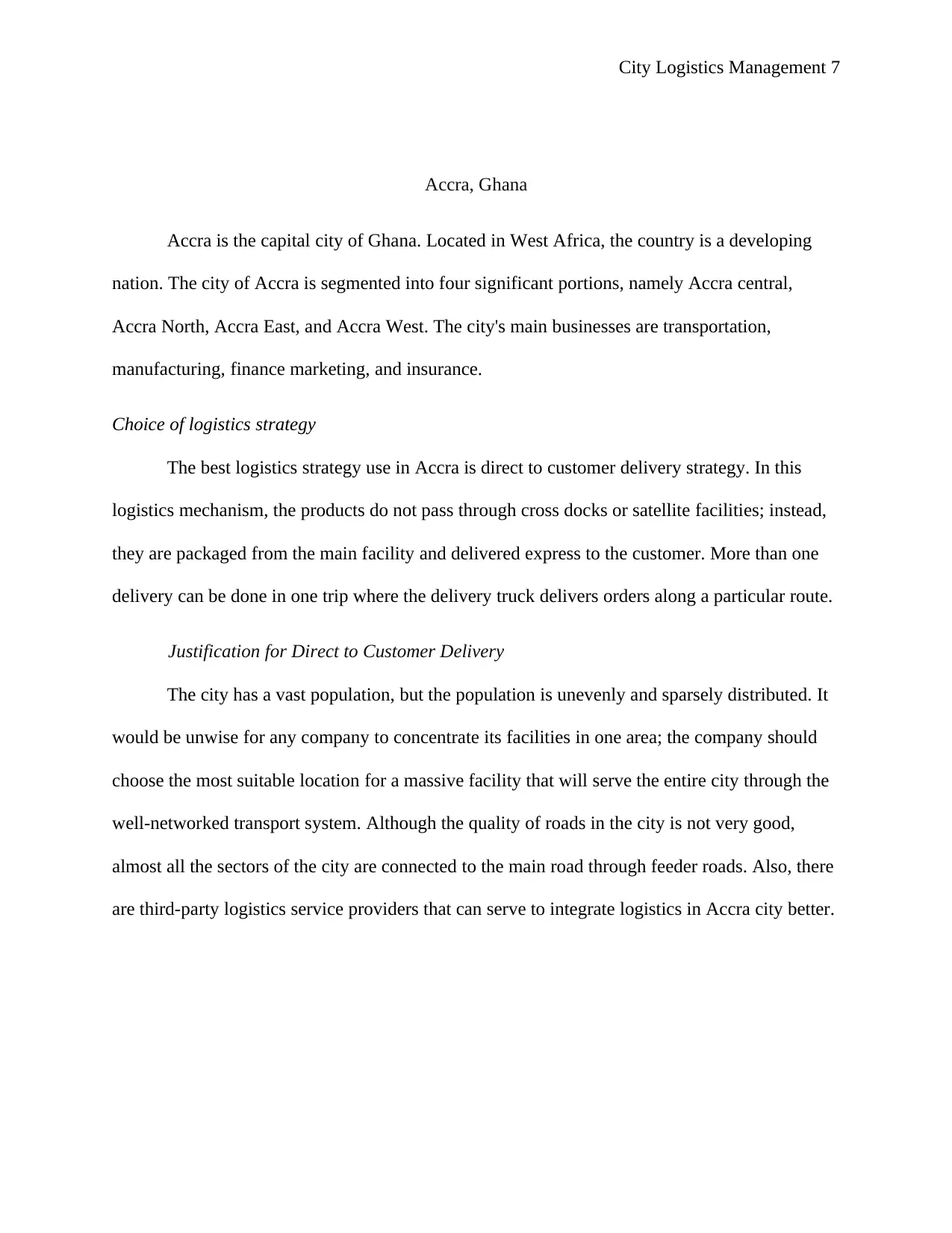
City Logistics Management 7
Accra, Ghana
Accra is the capital city of Ghana. Located in West Africa, the country is a developing
nation. The city of Accra is segmented into four significant portions, namely Accra central,
Accra North, Accra East, and Accra West. The city's main businesses are transportation,
manufacturing, finance marketing, and insurance.
Choice of logistics strategy
The best logistics strategy use in Accra is direct to customer delivery strategy. In this
logistics mechanism, the products do not pass through cross docks or satellite facilities; instead,
they are packaged from the main facility and delivered express to the customer. More than one
delivery can be done in one trip where the delivery truck delivers orders along a particular route.
Justification for Direct to Customer Delivery
The city has a vast population, but the population is unevenly and sparsely distributed. It
would be unwise for any company to concentrate its facilities in one area; the company should
choose the most suitable location for a massive facility that will serve the entire city through the
well-networked transport system. Although the quality of roads in the city is not very good,
almost all the sectors of the city are connected to the main road through feeder roads. Also, there
are third-party logistics service providers that can serve to integrate logistics in Accra city better.
Accra, Ghana
Accra is the capital city of Ghana. Located in West Africa, the country is a developing
nation. The city of Accra is segmented into four significant portions, namely Accra central,
Accra North, Accra East, and Accra West. The city's main businesses are transportation,
manufacturing, finance marketing, and insurance.
Choice of logistics strategy
The best logistics strategy use in Accra is direct to customer delivery strategy. In this
logistics mechanism, the products do not pass through cross docks or satellite facilities; instead,
they are packaged from the main facility and delivered express to the customer. More than one
delivery can be done in one trip where the delivery truck delivers orders along a particular route.
Justification for Direct to Customer Delivery
The city has a vast population, but the population is unevenly and sparsely distributed. It
would be unwise for any company to concentrate its facilities in one area; the company should
choose the most suitable location for a massive facility that will serve the entire city through the
well-networked transport system. Although the quality of roads in the city is not very good,
almost all the sectors of the city are connected to the main road through feeder roads. Also, there
are third-party logistics service providers that can serve to integrate logistics in Accra city better.
Paraphrase This Document
Need a fresh take? Get an instant paraphrase of this document with our AI Paraphraser

City Logistics Management 8
Conclusion
Tumon and Accra are two places that have great potential for growth and development;
logistics in these districts can best be managed through a combination of satellite facilities, direct
deliveries, and automated warehousing.
Conclusion
Tumon and Accra are two places that have great potential for growth and development;
logistics in these districts can best be managed through a combination of satellite facilities, direct
deliveries, and automated warehousing.
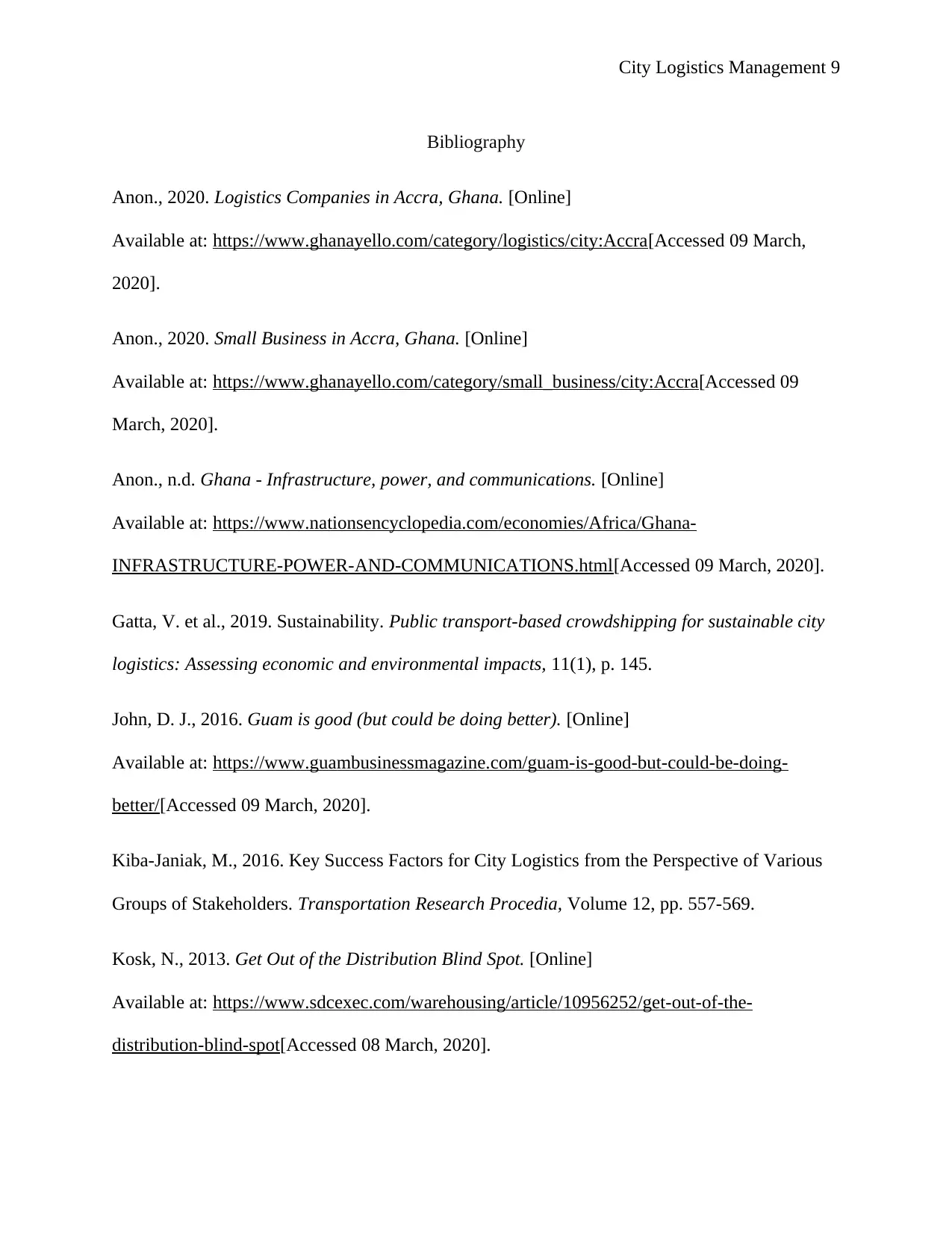
City Logistics Management 9
Bibliography
Anon., 2020. Logistics Companies in Accra, Ghana. [Online]
Available at: https://www.ghanayello.com/category/logistics/city:Accra[Accessed 09 March,
2020].
Anon., 2020. Small Business in Accra, Ghana. [Online]
Available at: https://www.ghanayello.com/category/small_business/city:Accra[Accessed 09
March, 2020].
Anon., n.d. Ghana - Infrastructure, power, and communications. [Online]
Available at: https://www.nationsencyclopedia.com/economies/Africa/Ghana-
INFRASTRUCTURE-POWER-AND-COMMUNICATIONS.html[Accessed 09 March, 2020].
Gatta, V. et al., 2019. Sustainability. Public transport-based crowdshipping for sustainable city
logistics: Assessing economic and environmental impacts, 11(1), p. 145.
John, D. J., 2016. Guam is good (but could be doing better). [Online]
Available at: https://www.guambusinessmagazine.com/guam-is-good-but-could-be-doing-
better/[Accessed 09 March, 2020].
Kiba-Janiak, M., 2016. Key Success Factors for City Logistics from the Perspective of Various
Groups of Stakeholders. Transportation Research Procedia, Volume 12, pp. 557-569.
Kosk, N., 2013. Get Out of the Distribution Blind Spot. [Online]
Available at: https://www.sdcexec.com/warehousing/article/10956252/get-out-of-the-
distribution-blind-spot[Accessed 08 March, 2020].
Bibliography
Anon., 2020. Logistics Companies in Accra, Ghana. [Online]
Available at: https://www.ghanayello.com/category/logistics/city:Accra[Accessed 09 March,
2020].
Anon., 2020. Small Business in Accra, Ghana. [Online]
Available at: https://www.ghanayello.com/category/small_business/city:Accra[Accessed 09
March, 2020].
Anon., n.d. Ghana - Infrastructure, power, and communications. [Online]
Available at: https://www.nationsencyclopedia.com/economies/Africa/Ghana-
INFRASTRUCTURE-POWER-AND-COMMUNICATIONS.html[Accessed 09 March, 2020].
Gatta, V. et al., 2019. Sustainability. Public transport-based crowdshipping for sustainable city
logistics: Assessing economic and environmental impacts, 11(1), p. 145.
John, D. J., 2016. Guam is good (but could be doing better). [Online]
Available at: https://www.guambusinessmagazine.com/guam-is-good-but-could-be-doing-
better/[Accessed 09 March, 2020].
Kiba-Janiak, M., 2016. Key Success Factors for City Logistics from the Perspective of Various
Groups of Stakeholders. Transportation Research Procedia, Volume 12, pp. 557-569.
Kosk, N., 2013. Get Out of the Distribution Blind Spot. [Online]
Available at: https://www.sdcexec.com/warehousing/article/10956252/get-out-of-the-
distribution-blind-spot[Accessed 08 March, 2020].
⊘ This is a preview!⊘
Do you want full access?
Subscribe today to unlock all pages.

Trusted by 1+ million students worldwide

City Logistics Management 10
Zeimpekis, V., 2011. Goods distribution management in the city logistics environment: A
systemic approach. Advances in Management & Applied Economics, 1(1), pp. 151-170.
Zeimpekis, V., 2011. Goods distribution management in the city logistics environment: A
systemic approach. Advances in Management & Applied Economics, 1(1), pp. 151-170.
1 out of 10
Your All-in-One AI-Powered Toolkit for Academic Success.
+13062052269
info@desklib.com
Available 24*7 on WhatsApp / Email
![[object Object]](/_next/static/media/star-bottom.7253800d.svg)
Unlock your academic potential
Copyright © 2020–2025 A2Z Services. All Rights Reserved. Developed and managed by ZUCOL.

